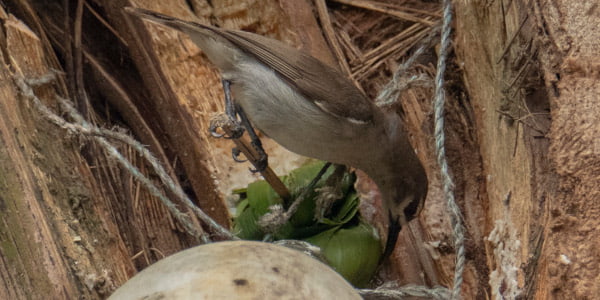LINKED PAPER
Human facilitation of sap-feeding birds in the Bijagós archipelago, West Africa. Gutiérrez, J.S. Catry, T. & Granadeiro, J.P. IBIS. DOI: 10.1111/ibi.12790. VIEW
Naturally fermented “palm wine” produced by oil palms (Elaies guineensis) is deeply rooted in West African culture and is the most frequently consumed alcoholic beverage — mainly in non-Islamic countries where alcohol consumption is not religiously prohibited. At least three species of birds drink the alcoholic sap. The new discovery — spied in Guinea-Bissau — is the first time African birds have been seen feeding on the sap flowing from holes made by local wine tappers (Fig. 1).

Figure 1 Local wine tapper harvesting wine from an oil palm on Orango island, Guinea-Bissau © Jorge Gutiérrez
During three months spanning the wet season, we witnessed the apparently unique sight in the forest of Orango Island, part of the Bijagós archipelago. We repeatedly observed Village Weavers (Ploceus cucullatus), Common Bulbuls (Pycnonotus barbatus) and Mouse-brown Sunbirds (Anthreptes gabonicus) perching on the containers placed by wine tappers to drink the sweet palm wine — which was about 6% alcohol by volume.
Video 1 Birds feeding on palm wine in the forest of Orango Island, Guinea-Bissau
Other birds in India (Rasal 2015) and chimpanzees (Pan troglodytes verus) in West Africa (Hockings et al. 2015) have also learned to take advantage of the containers that are left unattended throughout the day to drink the sweet palm wine. Unlike chimps, birds can’t use leaves to dip into the containers and retrieve the yummy boozy drink, but instead have to settle for the foamy sweet liquid that accumulates around the sap holes.
Clearly birds drank the sap by taking advantage of a human-made opportunity, representing a rare case of facilitation where humans, and not woodpeckers, indirectly provide food to birds that are not morphologically adapted to drill holes in trunks to feed on sap flows. Interestingly, birds seemed to be familiar with the location and productivity of the sap holes, as they typically arrived at active holes and foraged at the most productive one — based on the amount of sap in the containers. Some birds aggressively defended the sap holes from others, indicating that they compete over access to the sugar-rich resource. This human-bird association probably applies in a much broader geographic area and other species. Collaborative effort of ornithologists, amateur and professional alike, is needed to increase the records for new cases and expand our knowledge on this interaction.
We do not yet know whether the opportunistic drinking is another case of cultural innovation that could spread among wild birds (see Aplin et al. 2013, 2015), as it seems to be the case for sap-feeding chimpanzees (Hockings et al. 2015). Perhaps wine drinking is more frequent during dry season, when the supply of water and food resources is lower.
Although birds appear to consume some amount of alcohol as a by-product of sap fermentation, it is unclear how much they ingest and whether this can influence their behaviour. Although some animals, including birds, may accidentally get drunk from nectar or fermented fruit, the effects of alcohol consumption are probably unimportant. Nectarivorous and frugivorous birds’ high tolerance to fermented foods may have afforded them an evolutionary edge, since they could handle eating foods that other animals couldn’t. In addition, previous work suggests that birds (Mazeh et al. 2008), bats (Orbach et al. 2010) and butterflies (Beaulieu et al. 2017) from the tropics use physiological and behavioural mechanisms to avoid intoxication. Overall, alcoholic sap feeding birds seemed to have little trouble flying under the influence.
Nominate this article for a BOU Science Communication Award.
References and further reading
Aplin, L.M., Sheldon, B.C. & Morand-Ferron, A. 2013. Milk bottles revisited: social learning and individual variation in the Blue Tit, Cyanistes caeruleus. Anim. Behav. 85: 1225–1232. VIEW
Aplin, L.M., Farine, D.R., Morand-Ferron, J., Cockburn, A., Thornton, A. & Sheldon, B.C. 2015. Experimentally induced innovations lead to persistent culture via conformity in wild birds. Nature 518: 538–551. VIEW
Beaulieu M., Franke, K. & Fischer, K. 2017. Feeding on ripening and over-ripening fruit: interactions between sugar, ethanol and polyphenol contents in a tropical butterfly. J. Exp. Biol. 220: 3127-3134. VIEW
Hockings, K.J., Bryson-Morrison, N., Carvalho, S., Fujisawa, M., Humle, T., McGrew, W.C., Nakamura, M., Ohashi, G., Yamanashi, Y., Yamakoshi, G. & Matsuzawa, T. 2015. Tools to tipple: ethanol ingestion by wild chimpanzees using leaf-sponges. R. Soc. Open Sci. 2: 150150 VIEW
Marshall, M. 2019. Birds are stealing boozy palm wine when people aren’t looking. New Scientist. Available at: https://www.newscientist.com/article/2222856-birds-are-stealing-boozy-palm-wine-when-people-arent-looking. VIEW
Mazeh, S., Korine, C., Pinshow, B. & Dudley, R. 2008. The influence of ethanol on feeding in the frugivorous Yellow-vented Bulbul (Pycnonotus xanthopygos). Behav. Processes 77: 369–375. VIEW
Orbach D.N., Veselka N., Dzal Y., Lazure L. & Fenton M.B. 2010 Drinking and flying: Does alcohol consumption affect the flight and echolocation performance of phyllostomid bats? PLoS ONE 5(2): e8993. VIEW
Rasal, V. 2015. Sap-drinking by birds on tapped Indian date palm Phoenix sylvestris. J. Bombay Nat. Hist. Soc. 112: 102–103. VIEW
Image credit
Featured image: Mouse-brown Sunbird (Anthreptes gabonicus) feeding on palm wine in the forest of Orango Island, Guinea-Bissau © Jorge Gutiérrez



